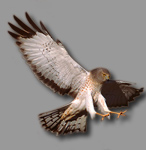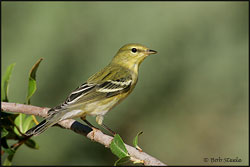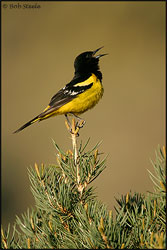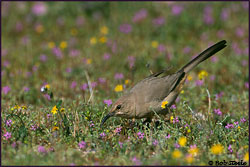|
Crouched low in my photo blind, I patiently wait for the target bird of the morning to hop up and sing on a perch I’ve staked out for an hour. Other birds are moving about – Lawrence’s Goldfinches, Blue Grosbeaks, Savannah Sparrows – all taking care of business in the hurried rush of spring. In the background I hear the song of a Lazuli Bunting not too far away. But wait; is it a Lazuli or an Indigo Bunting? They both breed here side-by-side, and even the occasional hybrid is found. The staccato calls of both Brown-crested and Ash-throated Flycatchers echo from the riparian forest nearby. A myriad of bird sounds, dozens of species, fill the air. It is early May at Audubon-California’s Kern River Preserve in north central Kern County, one of North America’s great birding locations. Focusing my attention back to the task at hand, it’s time to get to work. The Grasshopper Sparrow I’ve patiently been waiting for is right there – head cocked back, bill wide open – announcing to all in his buzzy song that this small patch of grassland belongs to him. A new sound is added to the cacophony of bird songs, the sound of my camera shutter clicking away.
Kern Plateau
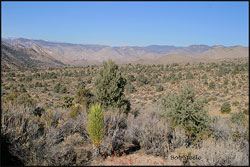 |
Kern County, California must be considered one of the most diverse ecological regions in California, if not North America. Kern contains five of California’s major ecological habitats – Central Valley, Chaparral, Mojave Desert, Great Basin, and Sierra Nevada.
This diversity in habitat types, and its location in multiple migration flyways, helps to explain the incredible number of species that reside or pass through. Boasting a list of well over 400 species, some impressive “Big Day” records have been recorded here. In 2002, John Sterling, et al. set the inland ABA Area County Big Day record of 202 species. And in 2004, Kern won the “America’s Birdiest Inland County” contest with an amazing 232 species recorded in a 48 hour period in May.
Birding is not limited to just one season either. Year-round opportunities exist throughout the area. From the grasslands of the west, the mountains and valleys in the middle, or the desert of the east, seasonal opportunities abound in a multitude of habitats.
To the West – Central Valley of California
Tricolored Blackbird
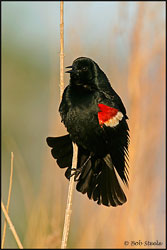 |
Kern’s western side is dominated by the southern San Joaquin central valley grassland habitat. Although some remnants remain, much of the native grasses of 200 years ago are long gone, replaced by exotic grasses and agriculture. Open areas of pine/oak woodland dominate the foothills. Several wildlife refuges and protected spaces are home to a vast number of wintering and nesting species. The nearly 11,000 acre Kern National Wildlife was established in 1960 to recreate wetland habitat replacing some lost to agriculture and development. Fall through spring is the best time to visit the refuge to see numerous duck species and other birds along the auto route. White-faced Ibis, numbering over 5000 birds, are an impressive spectacle there, and it’s a great spot to add Tri-colored Blackbird to your list. Hart Park, east of Bakersfield is 370 acres of open habitat with excellent opportunities year round. Over 270 species have been seen, including regulars like Hooded Merganser, Cassin’s Kingbird, Hooded Oriole, and a large feral population of Rose-ringed Parakeets.
The East Side – Mojave Desert
Joshua Trees
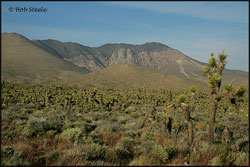 |
Eastern Kern is the Mojave Desert’s northern extreme. Relatively high in elevation at 2000 to 5000 feet, vast stretches of creosote bush and Joshua Tree forests dominate. Of particular interest to many birders are eastern Kern’s “migrant traps”, or desert oases, the most famous being Butterbredt Springs west of Red Rock Canyon State Park. A recognized “Nationally Important Bird Area”, Butterbredt is a favorite spring birding destination for locals and visitors alike. In this one small area of just a few acres, the spectacle of bird migration at its finest can be witnessed. The springs are located in a narrowing upslope canyon that naturally funnels northbound passerine migrants. When the wind blows, as it often does there on spring mornings, the migrants are pushed to near ground level. Arrive early and watch the display as hundreds or thousands of migrants pass per hour. All of the western warblers are possible, with Wilson’s, Black-throated Gray, “Audubon’s”, and Orange-crowned Warbler bordering on abundant some days. Warbling Vireo, Western Tanager, and Black-headed Grosbeak are often seen in large numbers, while Cassin’s Vireo, Lazuli Bunting, and several species of Empidonax flycatchers can be common. A typical birding list for one morning will often exceed 50 species and individual count numbers can be in the thousands. Local breeding specialties like Mountain Quail, Costa’s Hummingbird, Pinyon Jay, LeConte’s Thrasher, and Black-throated Sparrow are regularly sighted.
Butterbredt Springs
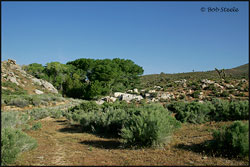 |
Butterbredt is also well known for its vagrants, especially eastern warblers, the goal for many late May visitors. A few of the vagrant warblers seen there in past years include Prairie, Worm-eating, Kentucky, and Black-throated Blue, have made visits an exciting outing of discovery. In all, 34 warbler species have been seen at Butterbredt. Regional compiler for North American Birds, John Wilson, has been birding Butterbredt for over 25 years. “Butterbredt Springs is arguably the best place in the western United States to witness the spectacle of spring migration. Its southeast to northwest juxtaposition seems to create the perfect corridor for migrants coming off of the desert and heading into the Sierra Nevada Mountains. I don't know of any other place in California where these migrants can be so readily seen. Butterbredt may be the only California location where both Blue-winged and Golden-winged warblers were seen on the same spring day. That created quite a stir, with parking that day at a premium.”
On the desert floor, numerous excellent birding spots exist. Central Park in California City is a favorite destination to see large numbers of western passerines and numerous eastern vagrants that often turn up during both spring and fall migration. Some notable regular vagrants include Blackpoll Warbler, American Redstart, Ovenbird, and Rose-breasted Grosbeak. Every so often a mega-rarity shows up at one of the desert oases. In 2001, Scott Terrill found the first lower 48 record for Eyebrowed Thrush near California City.
The canyons on the desert’s west edge are worth a look for migrants as well as nesting species including Ladder-backed Woodpecker, Cactus Wren, Sage Sparrow, and Scott’s Oriole.
In the Middle – Where It All Comes Together
Kern River Valley
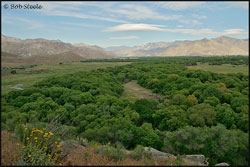 |
Running the length of the middle of the county is the southern terminus of the Sierra Nevada. Nestled in these mountains is the Kern River Valley, one of the first ten Globally Important Bird Areas designated in the U.S. (American Bird Conservancy). It is a birding paradise – 340 species of birds have been seen in the valley and encircling mountains, with nearly 200 species nesting. At an elevation of 2600 feet, the valley holds the largest remaining continuous stretch of Fremont cottonwood and red willow riparian forest in California, thousands of acres bordering the lower 14 miles of the South Fork Kern River, much of it protected. The federally endangered Southwestern Willow Flycatcher subspecies breed here as does the state listed western race of Yellow-billed Cuckoo. Both can regularly be seen and heard from visitor headquarters at Audubon-California’s Kern River Preserve in summer.
The Preserve is centrally located and a great spot to start a visit to the valley. Several trails leave from the visitor’s center. The trail leading west passes through possibly the best spot anywhere to see a Lawrence’s Goldfinch. From mid-May to late June, over 200 individuals are regularly seen within a few miles of preserve headquarters. Other trails lead to open fields and riparian habitat along the Kern River. In summer, expect to see and hear nesting species such as Summer Tanager, Blue Grosbeak, Yellow Warbler, and Yellow-breasted Chat. Seed, suet, and sugar-water feeders are maintained at the visitor’s center.
Western Tanager
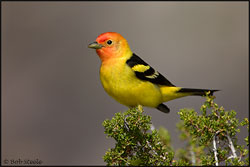 |
The valley is surrounded by mountains, and the influence of the five converging eco-habitats brings with it a spectacularly scenic and diverse location to do some world-class birding. Thousands upon thousands of birds migrate through the valley each spring. “A mid-April through mid-May morning walk along the Preserve’s Migrant Corner Trail can be among the ‘Best in the West.’ Scores to hundreds of Vaux’s Swifts, Western Tanagers, and Black-headed Grosbeaks pouring out of the riparian forest and close over the trail, Nuttall’s Woodpeckers and Canyon Wrens calling near at hand, a 70-100 species total, and the area’s surrounding beauty make for a truly unforgettable combination, ” said Bob Barnes, former Preserve outreach director.
Phainopepla
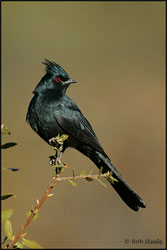 |
At the west end of the valley, the 580,000+ acre-feet Isabella Reservoir is a great winter spot to find Bald Eagle, Osprey, American White Pelican, four species of grebe, and several species of ducks including Common Goldeneye, Bufflehead, and all three species of merganser. Tillie Creek Campground near Wofford Heights at the west end of the reservoir will bulk your list with many chaparral species. California Quail, Acorn Woodpecker, Western Scrub-Jay, Oak Titmouse, Phainopepla, and Purple Finch are all common.
The Greenhorn Mountains rise dramatically from the west end of the reservoir. In 8 miles, Highway 155 rises from valley level to 6102 feet elevation at Greenhorn Summit. Along the way, the habitat changes from chaparral, to oak scrub, to montane. Species that can be seen as you journey up (several roads branch from the summit to other birding locations) range from California Thrasher to White-headed Woodpecker, Rufous-crowned Sparrow to Golden-crowned Kinglet, Wrentit to Mountain Chickadee.
Turkey Vulture
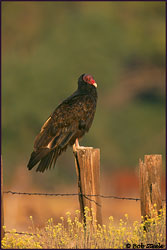 |
The valley plays host to a huge migration of Turkey Vultures in the fall. Terri Gallion, local resident and co-founder of the Kern Valley Vulture Watch notes, “For six hours each day, every day for one month, I sit on a desert hill. The Watch is a passion for me. I can't wait for the season to begin when I can sit on that hill and count some 30,000 Turkey Vultures on their annual migration. What a privilege to do this every year. Seeing vultures doing what vultures do, in their very vulture way. Getting to sit on that hill and work and think and meet so many people. Sometimes it is very quiet at the vulture count site and the silent flight of the vultures brings on a kind of meditation. When the vultures come, if there is chatter, it stops. I have not yet seen one person who was not struck silent, at least for a moment, by their ancient flight. Usually, their first words are ‘Wow’ and ‘Amazing’. In our seemingly jaded world, the little brother of the eagle still holds a lot of power.”
Costa's Hummingbird
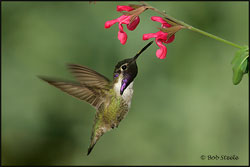 |
Hummingbirds are another grand attraction that draws birders to the valley. Costa’s, Anna’s, and Black-chinned nest on the valley floor, while Calliope nests in the mountains. It’s not unusual to see several hundred hummingbirds, dominated by Rufous, at preserve feeders during southbound migration in August and September.
The Kern River Valley hosts three birding festivals annually – celebrating migration in spring, hummingbirds in summer, and Turkey Vultures in the fall.
Whether you are a novice or expert birder, your interest ranges from casual to serious, you walk miles or observe from a vehicle, or you hope to bag a singing Grasshopper Sparrow photo, Kern County offers experiences galore. As the locals say, “Find It Here!”
More information:
Kern National Wildlife Refuge, Delano
Kern River Preserve, Weldon
Valley Wild Web Site
Where to bird in Kern County
Festivals -
Kern Valley Bioregions Festival – weekend closest to May 1
Kern Valley Hummingbird Celebration – end of July.
Kern Valley Turkey Vulture Festival – last weekend in September.
Books:
Birding Northern California by John Kemper covers bird finding in the central valley and Kern River Valley. Falcon Press. ISBN: 1560448326. March 1999.
A Birder’s Guide to Southern California (Lane/ABA Birdfinding Guide) by Brad Schram covers the desert part of the county. ABA. ISBN: 1878788175. September 1998
|
|
|
